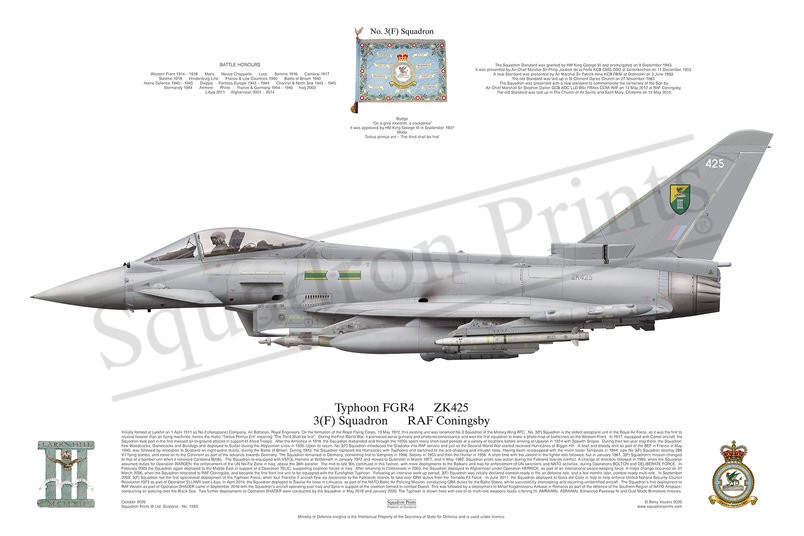#1583 Typhoon FGR4

Description
Squadron Prints Lithograph No. 1583 - ZK425, Typhoon FGR4, 3(F) Squadron, RAF Coningsby.
Initially formed at Larkhill on 1 April 1911 as No.2 (Aeroplane) Company, Air Battalion, Royal Engineers. On the formation of the Royal Flying Corps, 13 May 1912, this existing unit was renamed No.3 Squadron of the Military Wing RFC., No. 3(F) Squadron is the oldest aeroplane unit in the Royal Air Force, as it was the first to receive heavier than air flying machines, hence the motto “Tertius Primus Erit” meaning “The Third Shall be first”. During the First World War, it pioneered aerial gunnery and photo-reconnaissance and was the first squadron to make a photo map of battle lines on the Western Front. In 1917, equipped with Camel aircraft, the Squadron took part in the first massed air-to-ground attacks in support of Allied Troops. After the Armistice in 1918, the Squadron disbanded and through the 1920s spent many short-lived periods at a variety of locations before arriving at Upavon in 1924 with Sopwith Snipes. During their ten-year stay there, the Squadron flew Woodcocks, Gamecocks and Bulldogs and deployed to Sudan during the Abyssinian crisis in 1935. Upon its return, No 3(F) Squadron introduced the Gladiator into RAF service and just as the Second World War started received Hurricanes at Biggin Hill. A brief and bloody stint as part of the BEF in France in May 1940, was followed by relocation to Scotland on night-patrol duties, during the Battle of Britain. During 1943, the Squadron replaced the Hurricanes with Typhoons and switched to the anti-shipping and intruder roles. Having been re-equipped with the much faster Tempests in 1944, saw No 3(F) Squadron destroy 288 V1 flying bombs, and move on to the Continent as part of the advance towards Germany. The Squadron remained in Germany, converting first to Vampires in 1948, Sabres in 1953 and then the Hunter in 1956. A short time with the Javelin in the fighter role followed, but in January 1961, 3(F) Squadron’s mission changed to that of a bomber unit when it received Canberra B(I)8s. The Squadron re-equipped with VSTOL Harriers at Wildenrath in January 1972 and moved to Gutersloh in March 1977, and in May 1982, Squadron pilots saw action during the Falkland Islands conflict. A change of direction followed in 1993, when the Squadron assumed duties for Operation WARDEN, the enforcement of the UN No-Fly Zone in Iraq, above the 36th parallel. The mid to late 90s continued in this fashion, with more deployments to the Balkans and Iraq for enforcement of UN sanctions and NATO activities, during Operations BOLTON and DELIBERATE FORCE. In February 2003 the Squadron again deployed to the Middle East in support of o Operation TELIC, supporting coalition forces in Iraq. After returning to Cottesmore in 2003, the Squadron deployed to Afghanistan under Operation HERRICK, as part of an international peace-keeping force. A major change occurred on 31 March 2006, when the Squadron relocated to RAF Coningsby, and became the first front line unit to be equipped with the Eurofighter Typhoon. Following an intensive work-up period, 3(F) Squadron was initially declared combat-ready in the air defence role, and a few months later, combat-ready multi-role. In September 2009, 3(F) Squadron led the first operational deployment of the Typhoon Force, when four Tranche 2 aircraft flew via Ascension to the Falklands Islands to take over QRA duties from the Tornado F3 Force. In June 2011, the Squadron deployed to Gioia del Colle in Italy to help enforce United Nations Security Council Resolution 1973 as part of Operation ELLAMY over Libya. In April 2014, the Squadron deployed to Šiauliai Air base in Lithuania, as part of the NATO Baltic Air Policing Mission, conducting QRA duties for the Baltic States, whilst successfully intercepting and escorting unidentified aircraft. The Squadron’s first deployment to RAF Akrotiri as part of Operation SHADER came in September 2016 with the Squadron’s aircraft operating over Iraq and Syria in support of the coalition formed to combat Daesh. This was followed by a deployment to Mihail Kogălniceanu Airbase in Romania as part of the defence of the Southern Region of NATO Airspace, conducting air policing over the Black Sea. Two further deployments to Operation SHADER were conducted by the Squadron in May 2018 and January 2020. The Typhoon is shown here with one of its multi-role weapons loads: Litening III; AMRAAMs; ASRAAMs, Enhanced Paveway IV and Dual Mode Brimstone missiles.
